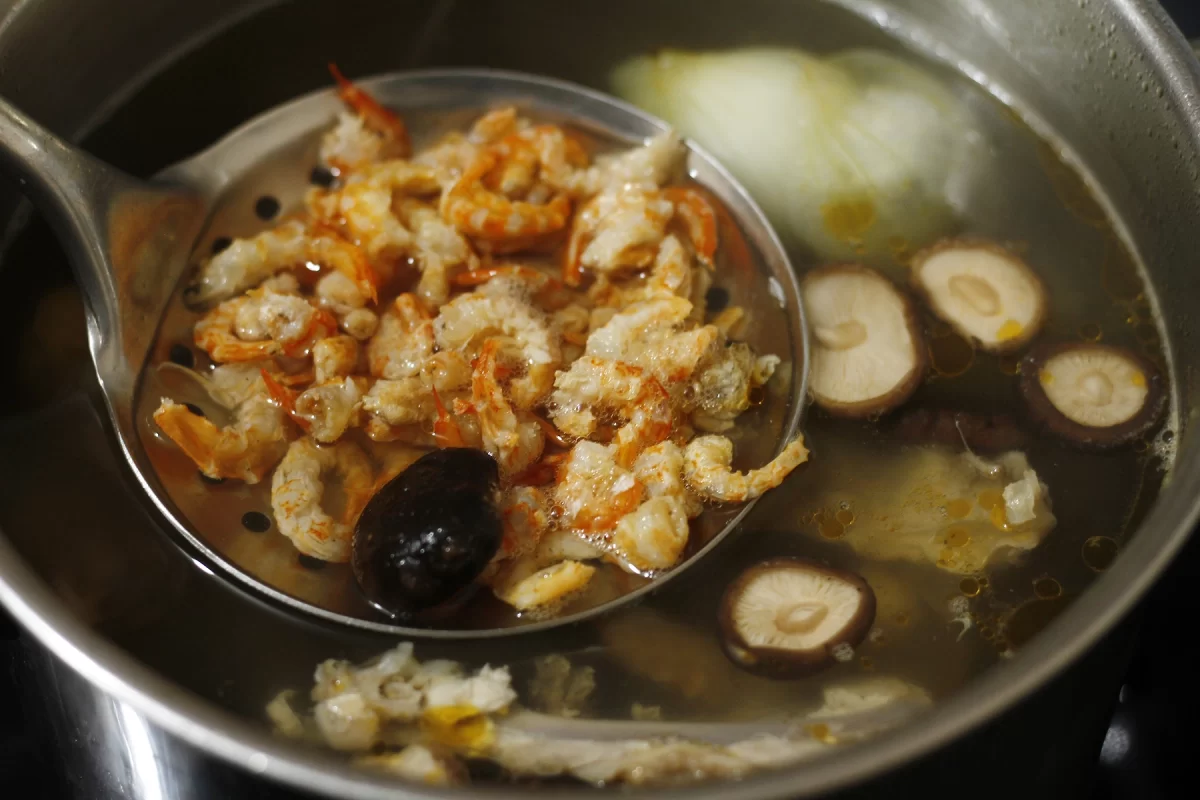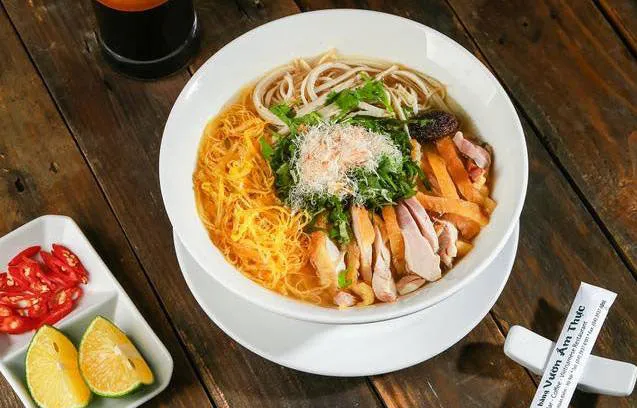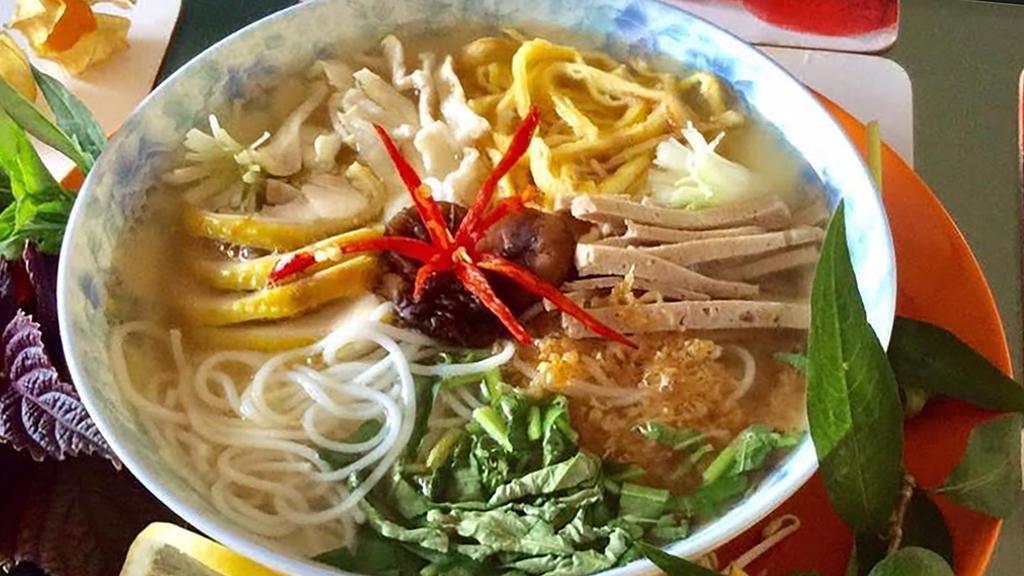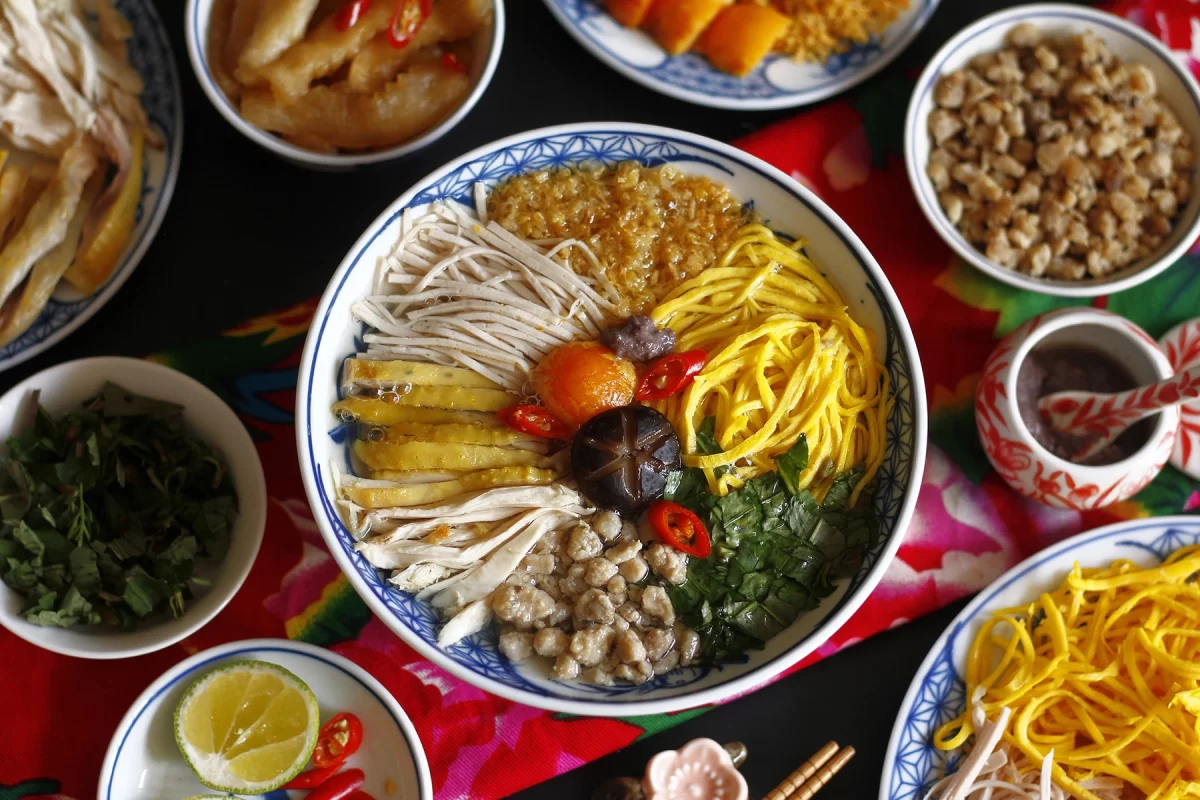Among Vietnam’s rich tapestry of noodle soups, few dishes embody the sophisticated essence of Hanoi’s culinary tradition quite like Bun Thang. This exquisite delicacy, characterized by its delicate broth and meticulously arranged toppings, represents the pinnacle of northern Vietnamese cuisine. At VietRice Essence Restaurant and Viet Rice Kitchen Cooking Class, we celebrate this iconic dish as a testament to the refined culinary heritage that has evolved over centuries in Vietnam’s historic capital.

The Poetry in a Bowl: What is Bun Thang?
Bun Thang is not merely a noodle soup—it’s an artistic composition of flavors, textures, and colors that exemplifies the subtle elegance of Hanoi cuisine. The dish consists of a light but deeply flavorful chicken broth served over fine rice vermicelli noodles (bún) and adorned with an array of thinly sliced toppings arranged with precision.
The name “Bun Thang” itself carries cultural significance. While several theories exist about its origin, the most widely accepted explanation relates to “thang thuốc Bắc” (northern Vietnamese herbal medicine), where multiple ingredients are combined in specific proportions to create medicinal harmony. Similarly, Bun Thang brings together numerous components in perfect balance, creating a culinary harmony that is greater than the sum of its parts.
At VietRice Essence Restaurant, our chefs often explain to guests that Bun Thang represents the philosophical approach to Vietnamese cooking: achieving complexity through simplicity, creating depth through careful balance, and elevating humble ingredients through meticulous technique.
A Glimpse Through Time: The History of Bun Thang
Royal Origins and Aristocratic Connections
Bun Thang’s history is intertwined with the sophisticated culinary culture that developed around the royal court and scholarly classes of ancient Hanoi (formerly Thang Long). Food historians generally place its origins in the late 18th or early 19th century, during a period when Hanoi’s culinary traditions were reaching new heights of refinement.
Some historical accounts suggest that Bun Thang originated in the kitchens of aristocratic Hanoi families who valued sophisticated presentation and subtle flavors. These households often employed skilled cooks who transformed leftover Tết (Lunar New Year) ingredients into new creations. According to this theory, Bun Thang emerged as an elegant solution for utilizing remaining holiday foods like chicken, eggs, and chả giò (Vietnamese sausage).
Other scholars connect the dish to the imperial cuisine of the Nguyen Dynasty (1802-1945), when court chefs developed increasingly refined techniques to please royal palates. The meticulous preparation and artistic presentation of Bun Thang certainly align with these royal culinary standards.
Evolution Through Social Changes
As Hanoi’s society evolved through French colonization, wars, and economic changes, Bun Thang gradually transitioned from exclusively aristocratic tables to wider appreciation. By the mid-20th century, it had become a beloved specialty in certain Hanoi neighborhoods, particularly the historic Old Quarter where many traditional recipes were preserved through generations of family businesses.
Despite its broader availability, Bun Thang retained its status as a special-occasion dish due to its complex preparation. It was often served at important family gatherings, celebrations, and as a show of hospitality to honored guests—a tradition that continues in many Hanoi households today.
Contemporary Significance
In modern Vietnam, Bun Thang stands as a culinary ambassador of Hanoi’s gastronomic heritage. While once limited to northern Vietnam, the dish now appears in Vietnamese restaurants worldwide, though rarely with the full complexity of authentic versions. Its elaborate preparation has made it a benchmark for measuring a chef’s skill and attention to detail.
At VietRice Essence Restaurant and Viet Rice Kitchen Cooking Class, we honor the historical journey of this remarkable dish by preparing Bun Thang with traditional methods while explaining its cultural significance to our guests. Our cooking classes often feature simplified versions that travelers can recreate at home, while our restaurant offers the full traditional experience.
The Symphony of Components: Breaking Down Bun Thang
The magic of Bun Thang lies in its harmonious combination of ingredients. Each component must be prepared separately with precision before being assembled in the final dish. Let’s explore the essential elements that create this culinary masterpiece:

The Foundation: Broth (Nước Dùng)
The soul of Bun Thang is its delicate yet deeply flavorful broth. Unlike the robust beef broths of phở or the pungent fermented broths of bún riêu, Bun Thang’s base is subtly aromatic and crystal clear.
Traditional preparation begins with a whole free-range chicken (gà ta), preferably an older hen with developed flavor. The chicken is gently simmered with charred ginger, roasted shallots, and occasionally dried squid or shrimp for depth. Some recipes include a small pork bone for additional richness. The critical technique is maintaining a very gentle simmer to ensure clarity while extracting flavor.
What distinguishes the broth from other chicken soups is the addition of “mắm tôm” (fermented shrimp paste)—just enough to create an elusive umami complexity without overpowering the delicate chicken flavor. This careful balance represents the sophisticated approach of Hanoi cuisine, where fermented elements are used with restraint compared to other regional Vietnamese cooking styles.
At VietRice Essence Restaurant, our chefs spend hours carefully skimming and straining the broth to achieve the perfect clarity and balance that authentic Bun Thang demands.

The Canvas: Rice Vermicelli (Bún)
The noodle component consists of fresh rice vermicelli (bún), which must be of the finest quality—thin, smooth, and with just the right firmness. Unlike the thicker noodles used in bolder soups, Bun Thang requires especially delicate strands that won’t overwhelm the subtle flavors of the broth and toppings.
Traditionally, the noodles are briefly dipped in the hot broth rather than being fully cooked in it, preserving their perfect texture until the moment of serving.
The Artistry: The Toppings
What truly distinguishes Bun Thang is its array of meticulously prepared toppings, traditionally arranged in separate sections atop the noodles like an artist’s palette. The classic version includes:
- Chicken (Gà): The simmered chicken (used for making the broth) is carefully shredded into fine strips. Some contemporary versions substitute poached chicken breast for a cleaner appearance, though traditionalists prefer the more flavorful meat from the whole chicken.
- Vietnamese Ham (Chả Lụa/Giò Lụa): This pork sausage is sliced into thin, uniform strips. The mild flavor and distinctive bouncy texture provide contrast to the softer chicken.
- Egg Threads (Trứng): Perhaps the most visually distinctive element, these are created by making a thin omelet, sometimes separately with egg whites and yolks to create yellow and white threads. The omelets are then rolled and cut into delicate julienne strips.
- Dried Vietnamese Sausage (Chả Quế): This aromatic pork sausage, flavored with cinnamon and other spices, adds another dimension of flavor and texture. It’s thinly sliced into matchstick-sized pieces.
- Vietnamese Coriander (Rau Răm): This distinctive herb with its unique peppery flavor is finely chopped and sprinkled as a garnish.
- Spring Onions (Hành Lá): Quickly blanched and cut into thin rings, these add a gentle allium note.
For special occasions or luxury versions, additional toppings might include:
- Shrimp Floss (Ruốc Tôm): Dried shrimp pounded into fluffy threads, adding concentrated umami.
- Shiitake Mushrooms (Nấm Hương): Thinly sliced and sautéed, contributing an earthy dimension.
- Duck or Quail Eggs: Sometimes substituted for or added alongside chicken eggs for variation.
The hallmark of expert Bun Thang preparation is that all toppings must be cut with absolute precision—each item should be uniformly thin and of similar length, creating a harmonious textural experience.
The Final Touches: Aromatics and Condiments
Just before serving, Bun Thang receives its finishing elements:
- Vietnamese Perilla (Tía Tô): These purple-tinged leaves add a distinct anise-like flavor.
- Banana Flower (Hoa Chuối): Thinly sliced and soaked in acidulated water to prevent browning, these add a slight astringency that balances the rich components.
- Chili Sauce (Tương Ớt): A small dish is provided alongside for diners to adjust the heat according to preference.
- Lime Wedges (Chanh): These brighten the flavor with a squeeze of fresh acidity.
- Additional Fermented Shrimp Paste (Mắm Tôm): Served on the side for those who enjoy a stronger flavor, this is traditionally diluted with lime juice and sugar.
At VietRice Kitchen Cooking Class, we guide participants through the preparation of each component, explaining how the flavors work together to create the harmonious whole that is Bun Thang.
The Sensory Experience: Tasting Bun Thang
When experienced properly, Bun Thang offers an extraordinary progression of flavors and textures that exemplifies the sophisticated nature of Hanoi cuisine.

Visual Appeal
Before the first taste, Bun Thang captivates with its visual presentation. The clear golden broth, white noodles, and colorful toppings create a feast for the eyes. Traditional presentation embraces a sense of artistic arrangement, with toppings placed in distinct sections rather than mixed together, allowing appreciation of each component’s color and form.
Aromatic Dimensions
As the bowl arrives, the diner first experiences the gentle aromatics rising with the steam—hints of chicken essence, subtle herbs, and the elusive depth from the minimal use of fermented shrimp paste. This aromatic experience is intentionally understated compared to many Vietnamese dishes, reflecting Hanoi’s preference for nuance over boldness.
Flavor Progression
The first spoonful of pure broth reveals its clarity and depth—simultaneously light yet profoundly satisfying. As one begins to incorporate the various ingredients, each bite offers a different combination of flavors and textures:
- The tender chicken provides a clean protein foundation
- The Vietnamese ham contributes a savory bounce
- The egg threads offer silky richness
- The herbs deliver bright, aromatic punctuations
- The dried sausage adds concentrated umami and aromatic spice notes
What makes Bun Thang truly special is how these distinct elements maintain their individual character while harmonizing into a cohesive whole. The experience evolves throughout the meal as the ingredients continue to infuse the broth with their essences.
Textural Symphony
Texture plays a crucial role in the Bun Thang experience. The smooth, slippery noodles contrast with the various toppings: tender chicken, slightly chewy ham, silky egg threads, and crisp herbs. This textural variety is intentional, creating interest that keeps each bite engaging.
Customization
Like many Vietnamese dishes, Bun Thang embraces personal adjustment. Diners traditionally fine-tune their bowl with additions of lime juice, chili sauce, or extra fermented shrimp paste according to preference. This customization is considered part of the interactive dining experience rather than a correction of the dish.
At VietRice Essence Restaurant, we serve Bun Thang with the traditional accompaniments and guide our guests through the customary eating process, encouraging them to experience the dish as locals would.
Beyond Ingredients: The Cultural Significance of Bun Thang
A Reflection of Hanoi’s Culinary Philosophy
Bun Thang embodies several key principles that define Hanoi’s gastronomic identity:
- Subtlety Over Boldness: Unlike the vibrant, herb-forward cuisines of central and southern Vietnam, Hanoi cooking celebrates restraint. Bun Thang’s delicate flavors exemplify this northern preference for nuance.
- Meticulous Technique: The labor-intensive preparation and precise cutting required for Bun Thang reflect the value placed on culinary craftsmanship in northern Vietnamese culture.
- Visual Harmony: The careful arrangement of ingredients demonstrates the traditional Vietnamese belief that food should nourish all senses, not just taste.
- Waste Reduction: The origin story involving the creative repurposing of Tết leftovers highlights the practical ingenuity that underpins even the most refined Vietnamese dishes.
- Five Elements Balance: Traditional Vietnamese culinary philosophy emphasizes balancing the five elements (wood, fire, earth, metal, and water) and their corresponding flavors (sour, bitter, sweet, spicy, and salty). Bun Thang achieves this balance through its carefully calibrated components.
Social and Ceremonial Roles
Throughout its history, Bun Thang has served important social functions:
- Hospitality Symbol: Offering Bun Thang to guests has traditionally signaled respect and a desire to impress, given the dish’s labor-intensive preparation.
- Family Cohesion: The complex preparation often became a multi-generational activity, with family members assigned different components according to their skills.
- Status Marker: In earlier eras, the ability to serve Bun Thang indicated a household’s refinement and resources.
- Cultural Preservation: Today, Bun Thang represents a living link to Hanoi’s culinary heritage, kept alive through family recipes and specialized eateries.
At VietRice Kitchen Cooking Class, we emphasize these cultural aspects alongside technique, helping visitors understand that learning to prepare Bun Thang is not just about following a recipe but connecting with centuries of tradition.
Regional Variations and Modern Interpretations
While Bun Thang remains primarily associated with Hanoi, variations have emerged across northern Vietnam and beyond:
Traditional Variations
- Nam Định Style: This variation from Nam Định province often includes water spinach and sometimes replaces the chicken with duck for a richer flavor profile.
- Vegetarian Version (Bun Thang Chay): Developed for Buddhist observances, this version substitutes mushroom broth and plant-based protein alternatives while maintaining the dish’s characteristic presentation.
- Royal Bun Thang (Bun Thang Hoàng Cung): This elevated version, claimed to be closest to the dish’s royal origins, includes luxury ingredients like shark fin (now usually substituted with more sustainable alternatives) and bird’s nest.
Contemporary Interpretations
As Vietnamese cuisine gains global recognition, creative chefs have begun reimagining Bun Thang while respecting its essential character:
- Fusion Approaches: Some modern Vietnamese restaurants incorporate non-traditional ingredients like sous-vide chicken breast, truffle oil, or even foie gras while maintaining the dish’s balanced spirit.
- Deconstructed Presentations: Avant-garde interpretations might present the components separately, encouraging diners to compose each bite according to their preference.
- Home-Friendly Simplifications: Recognizing the intimidating complexity of traditional preparation, contemporary cookbooks offer streamlined versions that capture the essence of Bun Thang with fewer steps.
At VietRice Essence Restaurant, we honor traditional preparation methods while acknowledging evolution. Our version stays true to Hanoi heritage while ensuring consistency and adaptability to available ingredients.
Experiencing Bun Thang at VietRice Essence and Viet Rice Kitchen
For visitors eager to experience this quintessential Hanoi delicacy, VietRice Essence Restaurant offers an authentic taste of Bun Thang prepared with meticulous attention to traditional techniques. Our chefs, trained in northern Vietnamese cuisine, prepare each component with care:
- Free-range chicken slowly simmered for the clearest, most flavorful broth
- Hand-cut toppings prepared with precision for uniform texture
- Traditional garnishes and condiments served alongside for customization
For those inspired to learn the art of preparing Bun Thang themselves, Viet Rice Kitchen Cooking Class offers specialized sessions focused on this iconic dish. Our instructors guide participants through:
- Broth Mastery: The secrets to achieving the perfectly clear yet flavorful foundation
- Precision Cutting Techniques: Hands-on practice creating the characteristic fine julienne toppings
- Ingredient Selection: Understanding how to choose and prepare each component
- Cultural Context: The history, serving traditions, and etiquette surrounding Bun Thang
- Simplified Home Versions: Adaptations that retain the essence while fitting modern lifestyles
Participants leave not only with recipes but with a deeper appreciation for the cultural significance behind this remarkable dish. We provide ingredient substitution guidance for those wanting to recreate Bun Thang in their home countries where certain traditional items might be difficult to source.

Nutritional Aspects and Dietary Considerations
Beyond its cultural and sensory appeal, Bun Thang offers nutritional benefits aligned with traditional Vietnamese dietary wisdom:
Balanced Nutrition
A traditional bowl of Bun Thang provides:
- Lean Protein: From chicken, eggs, and pork preparations
- Complex Carbohydrates: Via the rice noodles
- Micronutrients: Through the various herbs and vegetables
- Moderate Portion Size: Traditionally served in quantities that satisfy without excess
The combination of protein and carbohydrates delivers sustained energy, while the light nature of the dish leaves diners satisfied but not overly full—exemplifying the Vietnamese approach to balanced eating.
Adaptability for Dietary Needs
At VietRice Essence Restaurant, we recognize diverse dietary requirements and can modify Bun Thang accordingly:
- Gluten-Free Option: Traditional Bun Thang is naturally gluten-free when made with pure fish sauce (without additives)
- Lower-Sodium Version: Broth can be prepared with reduced salt while maintaining flavor through technique
- Vegetarian Adaptation: Our chefs can prepare a completely plant-based version upon request
During our cooking classes at Viet Rice Kitchen, we discuss these modifications and how they relate to Vietnamese culinary philosophy, which historically emphasized flexibility and making the most of available ingredients.
The Future of Bun Thang in Global Cuisine
As Vietnamese cuisine continues gaining international recognition, Bun Thang faces both opportunities and challenges:
Preservation vs. Evolution
The labor-intensive nature of authentic Bun Thang preparation presents challenges in fast-paced modern environments. However, this same complexity preserves its special-occasion status and cultural significance. The balance between maintaining authenticity and allowing natural evolution remains an ongoing conversation among Vietnamese culinary experts.
Global Appreciation
International interest in regional Vietnamese specialties beyond phở has created opportunities for dishes like Bun Thang to reach broader audiences. Food tourism, culinary education programs, and specialized Vietnamese restaurants worldwide help share the story of this remarkable dish.
Sustainability Considerations
Traditional Bun Thang embraces sustainability through its waste-reduction origin and efficient use of ingredients. Modern interpretations can enhance this aspect by emphasizing free-range poultry, seasonal herbs, and environmentally responsible sourcing.
At VietRice Essence Restaurant and Viet Rice Kitchen Cooking Class, we view ourselves as cultural ambassadors helping to secure a future for traditional dishes like Bun Thang through education, appreciation, and thoughtful adaptation.
The Enduring Legacy of Bun Thang
Bun Thang stands as a culinary poem composed of humble ingredients transformed through extraordinary care and technique. More than just a delicious meal, it represents the sophisticated culinary heritage of Hanoi—a tradition that values subtlety, balance, and meticulous attention to detail.
In each bowl of Bun Thang lies centuries of cultural history: the influence of royal courts, the resourcefulness of Hanoi households, the rhythms of seasonal celebrations, and the connectedness of family traditions. Every component, from the crystal-clear broth to the precisely cut toppings, tells part of this ongoing story.
As you explore Vietnam’s rich food culture, we invite you to experience Bun Thang at VietRice Essence Restaurant, where our chefs honor this remarkable tradition. For those wishing to delve deeper, our Viet Rice Kitchen Cooking Class offers the opportunity to learn the techniques and stories behind this elegant dish, creating memories and skills to take home along with your travel experiences.
In a world increasingly drawn to bold flavors and instant gratification, Bun Thang reminds us of the profound satisfaction found in subtlety, patience, and harmony—values that extend far beyond the dining table into the art of living itself.
VietRice Essence Restaurant & Viet Rice Kitchen Cooking Class
Your gateway to authentic Vietnamese culinary traditions
https://vietriceessence.com/
http://vietricekitchen.com/

